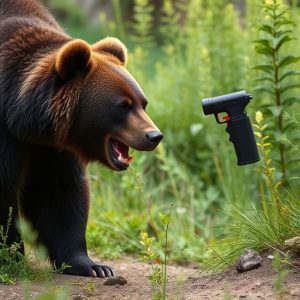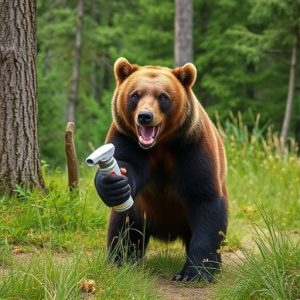Protecting Yourself: Bear Spray Ingredients, Application & Safety Beyond
Understanding bear behavior is crucial for safety in wilderness areas with bear populations, especia…….
Understanding bear behavior is crucial for safety in wilderness areas with bear populations, especially grizzlies and black bears known for territorial aggression. Bear spray, containing capsaicin at 20%-35%, acts as a potent deterrent when aimed correctly (at the face and eyes from 20-30 feet) to irritate bears' sensitive areas. Deciphering the Bear Spray Active Ingredient Percentage is key; higher percentages indicate greater effectiveness. Proper usage, regular training, testing, and replacement ensure optimal spray potency. Additional safety measures include knowing capsaicin concentrations (15%-20%), wearing protective clothing, carrying noise makers, avoiding high bear activity areas, traveling in groups, and securing food to minimize attracting bears by scent.
In the vast wilderness, encountering a bear can be a terrifying prospect. Understanding bear behavior and equipping yourself with the right tools are crucial steps in ensuring your safety. This article delves into the world of wilderness survival, focusing on bear attack protection. We explore the power of bear spray as a key defense mechanism, including how to interpret active ingredient percentage labels and apply it effectively. Additionally, discover other safety measures that go beyond bear spray use for comprehensive protection.
- Understanding Bear Behavior and Attack Patterns
- The Role of Bear Spray in Wilderness Survival
- Deciphering Bear Spray Active Ingredient Percentage Labels
- Effective Application Techniques for Maximum Protection
- Additional Safety Measures Beyond Bear Spray Use
Understanding Bear Behavior and Attack Patterns
Understanding bear behavior is crucial for anyone venturing into wilderness areas known for bear populations. Bears, particularly grizzly bears and black bears, have a strong sense of territory and often defend it aggressively, especially during mating season or when protecting their cubs. Recognizing attack patterns can significantly improve survival chances if you find yourself in such a situation.
One key factor to remember is that not all bear encounters end in an attack. Many bears are shy and will avoid humans unless they feel threatened or are defending food sources. Bear spray, which typically contains capsaicin with an active ingredient percentage ranging from 20% to 35%, can be a powerful deterrent when used correctly. Knowing how and when to deploy it can make the difference between avoiding a confrontation and deterring an attack.
The Role of Bear Spray in Wilderness Survival
In the harsh wilderness, where encounters with unpredictable wildlife are a reality, having the right tools for survival can mean the difference between life and death. One of the most effective deterrents against bear attacks is bear spray—a powerful chemical agent designed to protect adventurers in bear country. The key to its success lies in the active ingredient percentage, which typically ranges from 20% to 35%. This high concentration ensures that even a brief burst of spray can create a protective barrier around the user.
The active ingredient, often a pepper-based compound, provokes an immediate reaction when bears detect it. The spray irritates their eyes and nasal passage, temporarily disorienting them and allowing the human to escape or seek shelter. Proper usage involves aiming for the bear’s face and blowing the can in a sweeping motion. With regular training, individuals can learn to deploy bear spray effectively, increasing their chances of survival in bear-infested areas.
Deciphering Bear Spray Active Ingredient Percentage Labels
When considering bear spray as a protection against wild bears, it’s crucial to decipher the labels on the canisters. Understanding the Bear Spray Active Ingredient Percentage is key to making an informed decision. These percentages represent the concentration of the active ingredient responsible for repelling bears—typically a pepper-based compound. The higher the percentage, generally, the more effective the spray.
Looking at these labels, you may find terms like “10% Capsaicin” or “24% Active Ingredient.” This indicates that 10% of the total volume is pure capsaicin (the active ingredient) and the remaining 90% consists of other components such as water, preservatives, and propellants. Always check for the active ingredient percentage to ensure you’re getting a powerful enough spray for effective bear deterrence.
Effective Application Techniques for Maximum Protection
When it comes to bear spray, understanding the effective application techniques is key for maximum protection. Aiming correctly is crucial; hold the can at an angle, targeting the bear’s face and eyes, as this is where the active ingredient takes effect. The recommended distance for successful deployment is around 20-30 feet (6-9 meters), though this can vary based on factors like wind and spray pattern. A good practice is to practice with a training device or mock target to get a feel for the range and pressure required.
The active ingredient in bear spray, typically capsicum, has a concentration that varies by brand but is usually around 2% to 4%. This percentage, combined with proper application technique, can create an effective barrier against aggressive bears. It’s important to remember that bear spray is not a guaranteed solution; it’s one of several tools for wilderness survival, including awareness, noise making, and knowing how to react during an encounter. Regularly testing and replacing your spray according to manufacturer recommendations ensures its potency remains at optimal levels when you need it most.
Additional Safety Measures Beyond Bear Spray Use
When it comes to bear attack protection, going beyond bear spray is crucial for comprehensive safety in wilderness environments. While bear spray remains an essential tool, its effectiveness relies heavily on proper usage and understanding its active ingredient percentage—typically around 15-20% capsaicin. Beyond this, consider enhancing your defenses with robust clothing and gear. Waterproof, sturdy clothing can provide a physical barrier against bear claws, while thick gloves protect hands during encounters.
Additionally, carrying noise makers like whistles or bells can startle bears, giving you precious time to retreat. Knowing local bear behavior patterns and avoiding areas known for high bear activity is also proactive. Always travel in groups whenever possible, as bears are less likely to attack a larger party. Lastly, maintain food securely stored and avoid cooking near camp, as the scent can attract bears from great distances.
In conclusion, understanding bear behavior and utilizing bear spray effectively are paramount for wilderness survival. Deciphering bear spray active ingredient percentage labels ensures optimal protection, while proper application techniques maximize its efficacy. Beyond bear spray, additional safety measures such as making noise, traveling in groups, and securing food properly further mitigate risks during encounters with these majestic yet potentially dangerous animals. By combining knowledge, the right tools, and careful precautions, you can enhance your chances of staying safe in bear country.


